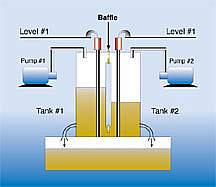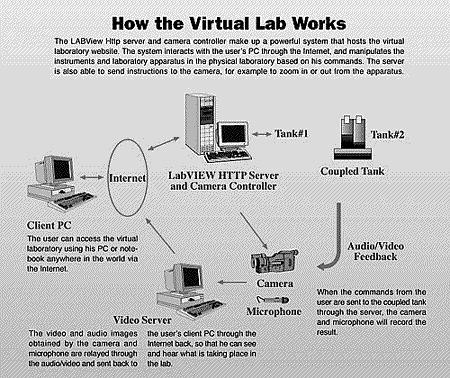
 ou are an electrical engineering student working on a project involving the coupled-tank system. Probes inside the tanks indicate on an external scale that the water levels in the two tanks are not the same. You need a little more water to balance the inflow and outflow rates. Working on your PC at home, you tune the control system that regulates the pumps to add water to one tank. And presto! The flow rates match, the baffle closes and the water level is finally level. ou are an electrical engineering student working on a project involving the coupled-tank system. Probes inside the tanks indicate on an external scale that the water levels in the two tanks are not the same. You need a little more water to balance the inflow and outflow rates. Working on your PC at home, you tune the control system that regulates the pumps to add water to one tank. And presto! The flow rates match, the baffle closes and the water level is finally level.
(Picture on right: The virtual laboratory allows the user to conduct experiments on the coupled-tank system)
Welcome to the Web-based world of virtual laboratories (VLAB), a pilot scheme launched in the Faculty of Engineering at the National University of Singapore. A virtual laboratory allows students and lecturers to conduct and test various control strategies for both teaching and research.
For months, electrical engineering undergraduates have been logging on to the university's virtual laboratory in their own time and from the comfort of their homes. All it takes is a powerful PC and the standard Web browsing software.
"The concept of virtual laboratories has been around for many years. However, whilst other virtual laboratories use simulation, we have developed it using real-time video feedback. You are able to make use of the mouse device to manipulate the control buttons and knobs of the instrument captured on camera at the actual site," explained Professor C C Ko of the Department of Electrical Engineering.
Ko and colleague Professor B M Chen have spearheaded a seven-member team to develop the system.
Rather than simulating what is happening in the real world, the system operates in real-time the video and audio representations of the actual instrument and apparatus located in the department's physical laboratory.
This is done through an audio-video server subsystem that includes monochrome and colour cameras for video capture, and microphones for audio capture. The captured video and audio representations are processed and temporarily stored in the audio-video server subsystem before they are transmitted to the computer for downloading and displaying. You can zoom in or out and even rotate the object up, down, left or right using this server.
"Users, whether they are students or researchers, can have only half an hour to work on the instruments. However, this time limit may be changed depending on the complexity of a particular project. Since the system is available 24 hours a day, users can log on any time. We now have researchers and students logging on to our system from all corners of the earth," explained Ko.
There are three virtual experiments available on the VLAB site. One is the coupled-tank experiment, and the others are experiments related to the use of an oscilloscope and a spectrum analyser in communications. Said Ko: "So far, feedback to the VLAB has been positive. Minor problems like accessing difficulties do happen now and then. Most of the time, it's because the browser and some of its components have not been set up properly. Sometimes, the problem is with the software. You do need properly configured software and the right PC speed to work on these experiments."
 With the oscilloscope experiment, undergraduates can measure remotely through the Internet various circuit responses such as amplitude, frequency, phase and step responses of some common circuits. Operation of the instrument is simple. Students simply have to connect the circuit by dragging the relevant lead and cables or control the instrument by turning knobs and pressing buttons using their mouse devices. They may also wish to work on more extensive research by keying in parameters for an experiment in the user interface. "Students who have problems working in the virtual laboratories can simply e-mail their lecturers. With the oscilloscope experiment, undergraduates can measure remotely through the Internet various circuit responses such as amplitude, frequency, phase and step responses of some common circuits. Operation of the instrument is simple. Students simply have to connect the circuit by dragging the relevant lead and cables or control the instrument by turning knobs and pressing buttons using their mouse devices. They may also wish to work on more extensive research by keying in parameters for an experiment in the user interface. "Students who have problems working in the virtual laboratories can simply e-mail their lecturers.
"Alternatively, users may also find from an online 'frequently-asked questions' solutions to their problems," Ko explained. However, even with the many benefits of virtual laboratories, Ko is certain that virtual laboratories will never replace classroom teaching.
"My prediction is that there will be more virtual laboratories in the future. Perhaps five years down the road, one-third of the experiments may be done virtually. However, the virtual laboratories are not established to replace face-to-face teaching but to allow the students to carry out the experiment before or after the real session," said Ko. "Virtual laboratories can only augment the lecturers' teaching tools. It can't replace them."
The virtual laboratory seems to be here to stay.
|



 ou are an electrical engineering student working on a project involving the coupled-tank system. Probes inside the tanks indicate on an external scale that the water levels in the two tanks are not the same. You need a little more water to balance the inflow and outflow rates. Working on your PC at home, you tune the control system that regulates the pumps to add water to one tank. And presto! The flow rates match, the baffle closes and the water level is finally level.
ou are an electrical engineering student working on a project involving the coupled-tank system. Probes inside the tanks indicate on an external scale that the water levels in the two tanks are not the same. You need a little more water to balance the inflow and outflow rates. Working on your PC at home, you tune the control system that regulates the pumps to add water to one tank. And presto! The flow rates match, the baffle closes and the water level is finally level.
 With the oscilloscope experiment, undergraduates can measure remotely through the Internet various circuit responses such as amplitude, frequency, phase and step responses of some common circuits. Operation of the instrument is simple. Students simply have to connect the circuit by dragging the relevant lead and cables or control the instrument by turning knobs and pressing buttons using their mouse devices. They may also wish to work on more extensive research by keying in parameters for an experiment in the user interface. "Students who have problems working in the virtual laboratories can simply e-mail their lecturers.
With the oscilloscope experiment, undergraduates can measure remotely through the Internet various circuit responses such as amplitude, frequency, phase and step responses of some common circuits. Operation of the instrument is simple. Students simply have to connect the circuit by dragging the relevant lead and cables or control the instrument by turning knobs and pressing buttons using their mouse devices. They may also wish to work on more extensive research by keying in parameters for an experiment in the user interface. "Students who have problems working in the virtual laboratories can simply e-mail their lecturers.